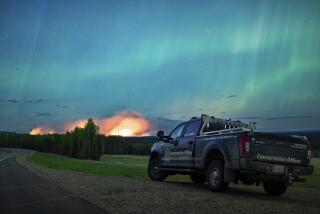Wyoming Wildfire Spreads
- Share via
JACKSON, Wyo. — Firefighters scrambled Saturday to extinguish spot fires around more than 100 forest homes as dry, gusty winds pushed a lumbering wildfire along the Snake River Mountains.
Joe Carvelho, a U.S. Forest Service commander, said he was uncertain whether the legion of 1,000 firefighters and aircraft dropping water and fire retardant would be able to keep the week-old blaze from reaching homes.
The fire, which has grown to about 4,800 acres, was acting like a heavyweight boxer, throwing erratic jabs along different fronts and threatening a knockout blow against the scattered homes, many of them valued in the millions of dollars.
The blaze is burning about seven miles southwest of this outdoors recreation mecca, which remains flooded with summer vacationers.
Carvelho delivered a good-news, bad-news report to homeowners who met Saturday morning at a community center.
While disaster was averted Friday as the most threatening front changed direction and moved away from the homes, Saturday’s weather conditions “spell disaster,” he told homeowners.
“We still feel very, very uncomfortable,” he said. “Mother Nature has tried everything in her power to beat us.”
As the fire continued to march toward the homes, firefighters prepared the structures for an anticipated fiery assault.
Sprinklers were placed atop roofs, spraying out water pumped from 1,200-gallon, pumpkin-orange bladders in front of the homes. The area’s three water tanks had been unwittingly drained dry by homeowners setting up their own sprinklers before evacuating their homes Wednesday, forcing firefighters to haul water in tender trucks to fill individual bladders, appearing as deep, industrial-strength wading pools.
“If we had had an emergency up there earlier, we wouldn’t have had a lick of water,” firefighter David Ronsen said. But he said he wasn’t necessarily complaining. “It’s their homes, and their water.”
A sticky gel fire retardant was sprayed on the more vulnerable homes closer to the blaze or shrouded by trees.
A few homes were sufficiently clear of vegetation to probably survive the fire, but many others were nestled below towering pines with branches hanging over their wood shingle roofs.
The fire is easily feeding off dead trees, diseased branches and grass that was extremely dry because of lack of rain, firefighters said.
Bryan Connelley, a Montana firefighter called to duty here, was positioned at a two-story, wood-and-glass home high on the mountain slope, where he watched the fire approach from the nearest ridge about half a mile away.
He chose his words carefully in describing the challenge facing firefighters because of people building homes in the woods.
“This is still America, and people should be able to do what they choose. But they should know that they are putting people in peril who are trying to now protect their homes.”
Making the stand against the fire all the more difficult are narrow, winding roads limiting the movement of fire equipment and posing the peril of gridlock should firefighters need to retreat.
There was little need for more firefighting resources, officials said, because the roads around the homes cannot accommodate any more than the 50 firetrucks already there, and the smoky sky was saturated with helicopters and air tankers swooping down through the smoke to deliver loads of water and retardant.
“Air traffic control around here is as good as it gets,” said Bobby Kitchen, a spokesman for the interagency firefighting task force.
The fire, which is burning mostly in the Bridger-Teton National Forest, probably was caused by human activity, perhaps a campfire, officials said.
More to Read
Sign up for Essential California
The most important California stories and recommendations in your inbox every morning.
You may occasionally receive promotional content from the Los Angeles Times.













